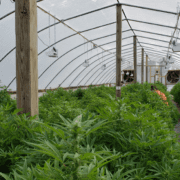3 Reasons Investors Are Reaping Benefits from Farmland Investments
Today, there are nearly 7.5 billion people on earth – a figure that is predicted to increase to nearly 10 billion by 2050. One common factor amongst each inhabitant of the world is the consumption of crops produced on farmland in one way or another. Agriculture produces the foods we eat, liquids we drink, clothes we wear, and even the furniture that we sit and sleep on. As the world’s population grows, so too will the demand for the farmland where these crops are grown.
For investors, the market for farmland is huge and presents significant opportunities for reducing risk and returning high yields. Additionally, investing in farmland generates stable income in the form of rent and capital gains as the land appreciates in value – while also helping investors to diversify their portfolios. And despite the over 1 million individual farmland owners in the United States, rented farmland accounts for 355 million acres of land nationwide totaling $32 billion in value. Additionally, farmland has historically outperformed stocks and bonds over the past 40 years with double-digit total yearly returns and extremely low volatility.
Although frowned upon only a decade ago, farmland investments are rapidly gaining interest and traction amongst institutional investors. Read ahead to learn more about why this alternative investment is generating high yields for modern-day investors.
The Limited Supply of Farmland
With a steadily growing demand and limited supply growth potential, a strong imbalance in the farmland market is present. This imbalance is the source of the rising farmland values that have occurred within past decades and that is anticipated to continue throughout this next decade. In 2019, the average cropland values rose 1.2% to $4,100 per acre in 2019 and average per acre rental rates rose from $138 in 2018 to $140 in 2019.
Undoubtedly, the limited supply of farmland has significantly boosted the speed at which these rates are climbing. Because only certain areas of the planet have suitable soil quality, water availability, and infrastructure, adding capacity is no easy feat. For investors, this imbalance of supply and demand is one of the economic drivers that is expected to result in further growth opportunities and steady cash flows from leasing land to farmers.
The Ongoing Demand for Food
Although farmland supply continues to be limited, there is still an ongoing demand for food that must be satisfied. In fact, it is estimated that global food production will need to increase by 60% within the next 30 years in order to meet the increasing demand for food. Similar to the effects of a limited supply of farmland, the rising demand for food is directly correlated to the steadily rising price of farmland. For investors, farmland has an attractive rate of appreciation and also pays significant yields. As the gap between supply and demand widens, farmland investors can expect to see even higher returns.
The Economic Resilience of Farmland
An increase in market volatility has driven investors to alternative assets that will remain stable throughout the varying economic cycles. Because of its strong and consistent risk-adjusted returns in relation to other asset classes and its history of preserving capital in times of economic downturns, farmland is capturing the interest of investors.
During the timeframe from December 2000 to December 2018, US farmland returns have continuously experienced similar levels of volatility as that of US 10-year bonds. Despite this similarity, farmland has historically outperformed 10-years bonds, delivering significantly higher yields. The low volatility of farmland is particularly attractive during financial uncertainties – and in the midst of these times farmland has a proven history of extreme resilience. In fact, during instances of economic uncertainty, US farmland has delivered only one quarter of negative returns since 1999. Additionally, when the S&P 500 declined, farmland continued to deliver positive returns. This extreme durability even during economic downturns is driven by today’s rapidly growing population and a limited supply of farmland from which to feed the masses.
The Diversification of Investment Portfolios
When balancing and diversifying a portfolio, investors typically seek investments with a low correlation – referring to how often the returns on two investments move together, either up or down. Over the past 40 years, farmland has demonstrated a low correlation to both stock and bond indexes. Because of this low correlation between farmland and stocks and bonds, many investors are viewing farmland as a strong tool for portfolio diversification. Furthermore, portfolio diversification with global farmland investments are also becoming an attractive alternative investment. Including global farmland investments in a portfolio can further reduce risk by spreading exposure amongst a variety of crops, government structures, and climates – making the impact of an unforeseen occurrence in one portion of the portfolio to be significantly reduced.
According to the Financial Times, there are a number of unique characteristics that support the case for including farmland in a diversified investment portfolio. These factors include its strong yields, low volatility, negative correlation to equities, and a resilience to economic cycles. With upside potential on the horizon, farmland investments are becoming a top commodity for investor seeking to diversify their portfolios – and many are already reaping the benefits of their investments.
Read Investing Outside the Box: Alternative CRE Investment Opportunities to learn more about alternative investment opportunities that are being taken advantage of today.




